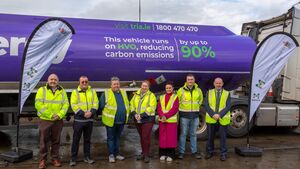Council takes 'significant step' to cut carbon emissions

Pictured at the first delivery of hydrotreated vegetable oil (HVO) by Mayo County Council were, from left: Conrad Harley, Acting Head of Roads, Mayo County Council; Ciaran Gielty, General Services Supervisor, Mayo County Council, Machinery Yard; Michael Cosgrove, General Services Supervisor, Mayo County Council, Machinery Yard; Michelle O’Sullivan, Senior Executive Engineer, Mayo County Council, Machinery Yard; Linda Cuffe, Procurement Officer, Mayo County Council; Joseph Browne, Energy Officer, Mayo County Council and Tom Gilligan, Director of Services for Housing, Roads and Services Development, Mayo County Council.
Mayo County Council has taken a significant step toward sustainability with the first delivery of hydrotreated vegetable oil (HVO) for its bulk fuel storage.
This transition is expected to reduce carbon emissions by 500 tonnes per year, equivalent to removing approximately 180 cars from Irish roads annually (based on an average of 2.75 tonnes of CO₂ emissions per car per year).
HVO is a renewable diesel alternative produced from waste vegetable oils and fats through a process called hydrotreatment. Unlike traditional fossil diesel, HVO is 100% fossil-free, biodegradable, and can be used in existing diesel engines without modification.
The benefits of HVO include:
Carbon Reduction: Up to 90% lower lifecycle CO₂ emissions compared to conventional diesel;
Improved Air Quality: HVO significantly reduces harmful pollutants such as nitrogen oxides (NOx) and particulate matter (PM), contributing to cleaner air and better public health;
Cold Weather Performance: Superior stability and performance in low temperatures compared to biodiesel.
Conrad Harley, Acting Head of Roads for Mayo County Council, said: “By adopting HVO, Mayo County Council is not only cutting greenhouse gas emissions but also improving local air quality, reducing pollutants that contribute to smog and respiratory issues.
“This initiative aligns with Mayo County Council’s climate action goals and demonstrates leadership in transitioning to sustainable energy solutions.”






